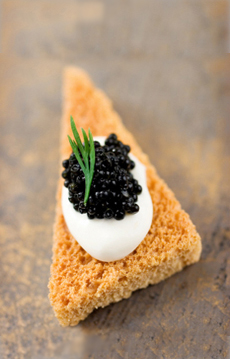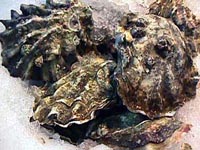|
|
The most abundant fish resource off the West Coast, Pacific whiting are also one of the best seafood values around. Their clean-tasting, white meat is easily adapted to a variety of applications, from fish and chips to pan frying or baking. |
 Photo courtesy of PacSeafood.com. |
Pacific whiting, or Pacific hake as it is sometimes called, is a member of the Merluccidae family, which includes more than a dozen species around the world that are marketed as either hake or whiting. Pacific whiting, Argentine hake and South African hake are the most abundant species in this family.
PERIWINKLE
|
The periwinkle, also called bigaros, sea snails or winkles, is essentially a sea snail. While there are over 300 species of this spiral-shelled univalve mollusk, few are edible, and are rarely found in the U.S. Like barnacles, they are found attached to sunken objects like rocks, wharves, and pilings. The most common edible periwinkle is marine and found along the Atlantic coasts of Europe and North America. It only grows to about one inch. Popular in Europe, they’re cooked in their shells, then eaten like escargots. |
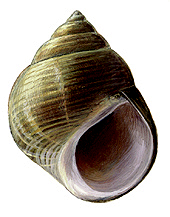 Photo courtesy of Irish Sea Fisheries Board. |
PISMO CLAM
|
The Pismo clam, named after Pismo Beach, is one of the largest types of clams found along the California Coast. The clams can grow up to seven inches; the minimum legal size for clamming is 4.5 inches. The adductor, the muscle which hinges the two shells, is served on the half shell; while the body meat is cooked or chopped up for chowder. The Pismo is considered the best of the Pacific hard-shell clams, but it is suffering from overfishing. |
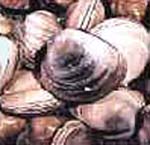 |
POLLOCK
|
Pollock are a member of the cod family. The Theragra chalcogramma are also called Alaska pollock or Walleye pollock. They differ from other codfish because their lower jaw extends beyond the upper jaw. Pollock is a mild, delicately flavored fish, with a slightly coarse texture. Cooked pollock is lean, white and moist. The texture is firm with a nice flake. |
 Photo courtesy of TridentSeafoods.com. |
POMPANO
|
A member of the jack family, this saltwater fish is found in waters off South Atlantic and Gulf states. Its succulent, fine-textured, moderately fat flesh has a mild, delicate flavor. It is considered by many to be America's finest fish, and it is priced accordingly. The most famous dish made from this fish is pompano en papillote, where it’s baked in parchment paper with mushrooms and a velouté sauce. The fish called Pacific pompano is a variety of butterfish. |
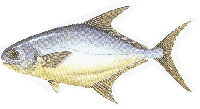 |
PORGY
PRAWN
|
A term commonly used to refer to freshwater shrimp, larger sized shrimp, or a smaller variety of shellfish, that is a member of the lobster family. This term causes a lot of confusion because, in the U.S., it is used to describe several different shellfish, all of which are “correct” usages.
|
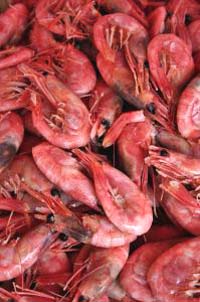 Photo courtesy of Sxc. |
- The term also refers to freshwater prawns, distinguished from shrimp that live in salt water. Actually, these prawns migrate to fresh water to spawn, just like salmon. They look like elongated lobsters, with long, spindly legs.
PUFFERFISH
|
Pufferfish, warm water fish, are the second most poisonous vertebrate in the world (the first is the Golden Poison Frog). The skin and certain internal organs are highly toxic to humans; perhaps for this reason the meat of some species is considered a delicacy, particularly in Japan (as fugu) and Korea (as bok-uh). Thick gloves should be worn while fishing to avoid poisoning from the skin or by getting bitten when removing the fish from the hook. |
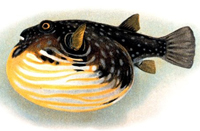 White-spotted puffer. Photo courtesy of Wikipedia Commons. |
QUAHOG
|
A term from the Narragansett Indians used loosely for all sizes of East Coast hard-shell clams, but especially the largest size, also known as the chowder (or large) clam. |
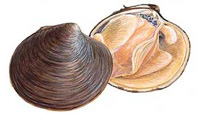 |
ROCKFISH or ALASKAN ROCKFISH
|
The Alaskan rockfish is a lean, high-quality, ocean-fresh fish, characterized by a firm, meaty flesh that turns snow white when cooked. It has a delicate, nutty, sweet flavor. Rockfish belong to the family Scorpaenidae, or scorpionfishes. Common market names include Pacific red snapper, rock cod and Pacific ocean perch. |
 Photo courtesy of TridentSeafoods.com. |
Recognizable by the sharp spines on their dorsal fins, rockfish vary in length from 20" to 37" and may weigh up to 30 pounds. A versatile fish, the Alaska rockfish takes well to a wide range of cooking methods.
ROCK LOBSTER
|
See spiny lobster. |
ROE
|
The eggs of a fish. The term “roe” encompasses everything from lobster coral to rare Caspian sturgeon caviars like beluga and osetra. While “caviar” formerly referred exclusively to sturgeon caviars, it has become interchangeable with “roe,” e.g., salmon caviar and whitefish caviar. See our Caviar Glossary for more information. |
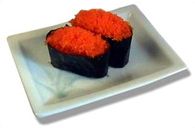 Capelin caviar or tobiko, harvested from an Icelandic fish. |
Continue To Page 11: Seafood Terms Beginning With S
Go To The Alphabet Index Above
Lifestyle Direct, Inc. All rights reserved. Images are the copyright of their respective owners.
![]()
© Copyright 2005-2025 Lifestyle Direct, Inc. All rights reserved. All images are copyrighted to their respective owners.




